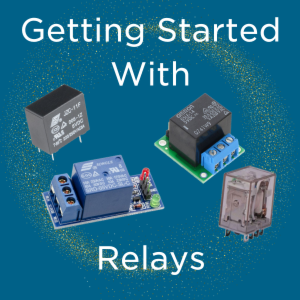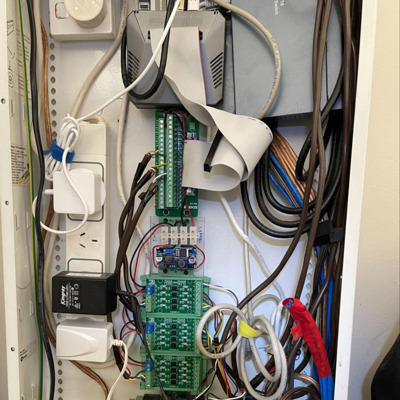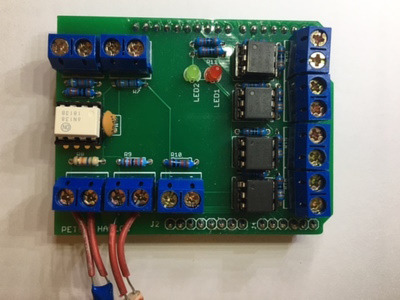Pololu RC Switch with Isolated Solid State Relay/Switch, SPST, 60V, 6A
Available with a lead time
Expect dispatch between Jan 13 and Jan 16
 |
This product consists of a solid state, single-pole, single-throw (SPST) relay and a control circuit that measures incoming radio control (RC) signals, enabling control of large, electrically isolated loads in RC systems. Example applications include using extra channels on an RC receiver or servo controller to turn on lights, motors, or irrigation valves.
The RC switch measures the width of incoming RC pulses and compares it to a user-configurable threshold (with ±64 µs of hysteresis) to decide whether to activate the relay. By default, the threshold is approximately 1700 µs, with switch activation occurring above the threshold (longer pulses), but the switch has a learning mode that allows you to change the threshold and the activation direction. A safe-start feature reduces the likelihood of unexpected activation.
The switch control circuit operates from 2.7 V to 16 V, which is wider than the typical range of an RC receiver and can typically be supplied by the RC receiver or servo controller itself.
The switching is performed by a pair of MOSFETs controlled by an optically isolated driver that galvanically isolates the load from the control inputs. The MOSFETs are arranged back-to-back to make the two outputs symmetric and equivalent, allowing bidirectional current control with the switch in any orientation relative to the load (for example, this board can be used for high-side or low-side switching). Benefits over modules with mechanical relays with comparable current ratings include silent operation, a smaller form factor, and immunity to problems like contact wear and arcing that limit the service life of mechanical relays.
Versions of this switch are available with different voltage and current capabilities, and each of those is available with connectors soldered or without connectors:
| Max load voltage | Max load current | Connectors | Item # |
|---|---|---|---|
| 60 V | 6 A | soldered | #5422 |
| not included | #5423 | ||
| 30 V | 10 A | soldered | #5424 |
| not included | #5425 |
Details for item #5423
|
|
This RC switch version can switch up to 6 A of current at voltages up to 60 V (absolute maximum). The output MOSFETs have a typical combined resistance of 30 mO when the relay is enabled. It does not include any connectors.
The control pins work with 0.1"-pitch header pins and are compatible with standard solderless breadboards. The load side of the board has 0.045"×0.095" slots that can accommodate 3.5mm-pitch and 5mm-pitch terminal blocks, a 1×2 0.2"-pitch header, or a 1×3 0.1"-pitch male header with the middle pin removed. Wires can also be soldered directly to the slots for high-current applications.
Using the solid state relay/switch
 |
The control circuit pins are accessible along one side of the board and the load connection slots are located along the other side of the board. The control circuit is powered by supplying 2.7 V to 16 V across the VRC and GND pins, and it is controlled by an RC signal supplied on the RC IN pin. The output switch is made from a pair of back-to-back MOSFETs, so it is symmetric and bidirectional, and this board can be used as a high-side switch or low-side switch. The board’s control circuit will typically draw up to 15 mA from VRC when the switch is enabled.
The OUT pin is a digital output that indicates whether the switch is active. A high value means the switch is active, and a low value means it is not active.
The GOOD pin is a digital output that indicates whether the supplied RC signal is valid (10–330 Hz pulse rate, 0.5–2.5 ms pulse width). When the GOOD pin is low, it means the signal is invalid. In that situation, the OUT pin will also be low.
The high voltage level for OUT and GOOD is equal to VRC for VRC voltages of 2.7 V to 5 V, and it is 5 V for VRC voltages above 5 V.
A yellow indicator LED is also used to shows what state the device is in. See the user’s guide for more information about the indicator LED and learning mode jumper, which can be used to adjust the activation threshold of the switch.
Typical connection diagrams for use in RC systems
 |
Typical wiring diagram for the Pololu RC Switch with Isolated Solid State Relay/Switch, SPST. |
|---|
For inductive loads powered from a DC supply, a flyback diode (also called a freewheeling diode) can be connected across the load as shown below to reduce inductive voltage spikes when the switch turns off.
 |
Typical wiring diagram for the Pololu RC Switch with Isolated Solid State Relay/Switch, SPST when using a DC load supply with an inductive load. |
|---|
Real-world power dissipation considerations
In Pololu's tests, Pololu found that the 30 V version of the relay/switch could conduct about 10 A continuously, and the 60 V version could conduct about 6 A continuously, without reaching the thermal limit for the MOSFETs. Pololu's tests were conducted at approximately 25°C ambient temperature with no forced air flow.
The actual current you can pass through the board will depend on how well you can keep it cool. The printed circuit board is designed to help with this by drawing heat out of the MOSFETs. Solid connections to the output pins (such as with thick soldered wires) can also help reduce heat build-up in the MOSFETs and board.
Warning: Exceeding temperature or current limits can cause permanent damage to the MOSFETs. If you are switching an average continuous current greater than about 2/3 of the specified maximum, Pololu strongly recommend that you monitor the MOSFETs’ temperature and look into additional cooling if necessary.
This product can get hot enough to burn you long before the chip overheats. Take care when handling this product and other components connected to it.
Creepage and high voltage isolation considerations
This product is designed to be compact, without consideration for extra creepage that is often associated with solid state relays and electrically isolated systems. As such, this product is not suitable for isolating regions at significantly different voltages. For an alternative that can provide the same functionality with significantly higher isolation voltage ratings, consider using Pololu's RC Switch with Digital Output with Pololu's Isolated Solid State Relays.
Schematic and dimension diagrams
 |
Schematic diagram of the Pololu RC Switch with Isolated Solid State Relay/Switch, SPST. |
|---|
The dimension diagram is available as a downloadable PDF (299k pdf).
Dimensions
| Size: | 0.7" × 0.5" × 0.13" |
|---|---|
| Weight: | 0.6 g |
General specifications
| Minimum control voltage: | 2.7 V1 |
|---|---|
| Maximum control voltage: | 16 V1 |
| Maximum input current: | 15 mA2 |
| Maximum load voltage: | 60 V |
| Maximum load current: | 6 A |
| Maximum on resistance: | 30 mO |
| Connectors?: | N |
Identifying markings
| PCB dev codes: | rcs04a |
|---|---|
| Other PCB markings: | 0J15651 |
Notes:
- 1
- VRC.
- 2
- When switch is on; 5 mA when switch is off.
Documentation and other information
Pololu RC Switch User’s Guide (Printable PDF)
User’s manual for the Pololu RC Switch with Medium Low-Side MOSFET and the Pololu RC Switch with Relay.
File downloads
Dimension diagram of the Pololu RC Switch with Isolated Solid State Relay/Switch, SPST (299k pdf)
3D model of the Pololu RC Switch with Isolated Solid State Relay/Switch, SPST (5MB step)
Drill guide for the Pololu RC Switch with Isolated Solid State Relay/Switch, SPST (204k dxf)
This DXF drawing shows the locations of all of the board’s holes.
Exact shipping can be calculated on the view cart page (no login required).
Products that weigh more than 0.5 KG may cost more than what's shown (for example, test equipment, machines, >500mL liquids, etc).
We deliver Australia-wide with these options (depends on the final destination - you can get a quote on the view cart page):
- $3+ for Stamped Mail (typically 10+ business days, not tracked, only available on selected small items)
- $7+ for Standard Post (typically 6+ business days, tracked)
- $11+ for Express Post (typically 2+ business days, tracked)
- Pickup - Free! Only available to customers who live in the Newcastle region (must order online and only pickup after we email to notify you the order is ready). Orders placed after 2PM may not be ready until the following business day.
Non-metro addresses in WA, NT, SA & TAS can take 2+ days in addition to the above information.
Some batteries (such as LiPo) can't be shipped by Air. During checkout, Express Post and International Methods will not be an option if you have that type of battery in your shopping cart.
International Orders - the following rates are for New Zealand and will vary for other countries:
- $12+ for Pack and Track (3+ days, tracked)
- $16+ for Express International (2-5 days, tracked)
If you order lots of gear, the postage amount will increase based on the weight of your order.
Our physical address (here's a PDF which includes other key business details):
40 Aruma Place
Cardiff
NSW, 2285
Australia
Take a look at our customer service page if you have other questions such as "do we do purchase orders" (yes!) or "are prices GST inclusive" (yes they are!). We're here to help - get in touch with us to talk shop.
Have a product question? We're here to help!
Videos
View AllGuides
Getting Started With Relays | Examples with Raspberry Pi Pico
How to use a PiRelay HAT for Raspberry Pi - Multiple Relay Control with Voice or GUI
The Maker Revolution
Relay Operation and the Arduino Uno
Projects
Smart Home Makeover with HomeAssistant
PowerPlay SSR Control
Smart Watering System
Makers love reviews as much as you do, please follow this link to review the products you have purchased.




















Product Comments